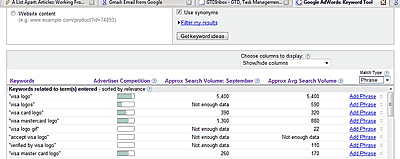If you Don't Already Get Spam
First and foremost, never put your email address anywhere out the internet where it will be visible on a page. If you do put it out there, you will get spam. Do not register a domain name without whois protection. If your registrar can't hide your email in the domain registration records, use a Gmail acct for your domain contact.(see below).
Next, Have two email addresses.
One gives you everything you really need to see, the other is for all the misc. stuff.
Your PRIVATE email is one that you only give out to real actual live people (and maybe your bank or another business with which you have a private and trusting relationship)
The other email is your PUBLIC email address, and I suggest a Gmail address for this, because Gmail has the greatest spam filters in the world. This address is used for newsletters, Amazon orders, and friends that like to send FW: RE: emails.
I collect email from these two addresses in two separate email programs (Outlook and Thunderbird). That way my private email account only gets mail from people I REALLY want to hear from. It cuts down on the distractions in a BIG way.
If you give your email address to someone who likes to send FW: RE: type emails, get them to change to start sending stuff to you at your public (Gmail) account, or sooner or later your PRIVATE email addr will end up on a computer that is virus infected and you will start to get spam. This has happened to me.
For an email address that gets spam, a couple ideas.
You can set up Gmail to receive your email, and then you can set up Gmail and your email program (Outlook, Thunderbird...) to get the email from Gmail. That way your email gets filtered by Gmail. Gmail's filters are so good that one of my clients had 2000+ spams filtered out, 2 that got through and no false positives.
Outlook has pretty good spam filters. Update Outlook at Office Update, and then set Outlook's junk mail options to High. What happens for me is that almost all the spam goes into the Junk folder, and I also get false positives on a regular (predictable) basis. The false positives are fairly easy to deal with. I only get them once, and I only get them from new correspondents. I keep and eye on the contents of my junk folder and 'mark as not junk' any emails coming from a real person. Now, I don't have a lot of new correspondents, and I don't get thousands of spams, so this works for me.
If you have your own domain and website, you can even change your MX records so that Google apps for domains collects your email, instead of your hosting company's email servers. Again, you get the benefit of Gmail's awesome spam filters. I set this up for a client and it's been awesomely successful. It's transparent for the client, he just collects his email in Outlook the same way he did previously.
Get an Antivirus program - You absolutely must have an antivirus program.
AVG Free Download
Comodo Antivirus free
NOD32 - Best paid antivirus

 Click for larger image
Click for larger image